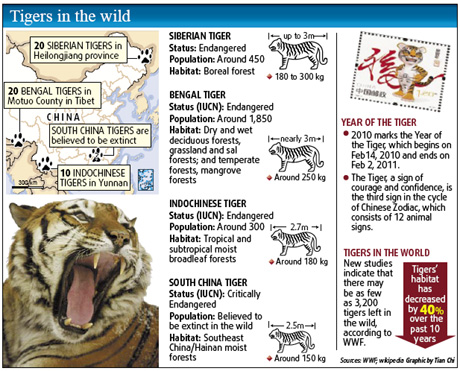Society
Tigers in wild face risk of extinction
By Wang Zhuoqiong (China Daily)
Updated: 2010-01-19 08:08
 |
Large Medium Small |
Experts call for better habitats, end to poaching and illegal trade

Wild tigers in the country face the danger of extinction in about three decades if loss of habitats and illegal trade continue, the World Wide Fund for Nature (WWF) has warned.
"If urgent and proper measures are not taken, there is a risk that wild tigers will no longer be found on Chinese territory," Zhu Chunquan, conservation director of biodiversity of WWF China Program Office, told China Daily yesterday.
The warning came as the country marks the Year of the Tiger next month. The animal tops WWF's list of "10 to Watch in 2010", followed by polar bears, pandas and rhinos.
The tiger is believed to be native to China, which evolved into eight subspecies.
But the country now has only about 50 wild tigers - in four subspecies - Wang Weisheng, director of the wildlife management division of China's State Forestry Administration (SFA), told China Daily.
South China tigers are believed to be extinct in the wild after the species has not been sighted for more than 25 years, according to WWF.
The country is left with 20 Siberian tigers, 10 to 20 Bengal tigers and 10 Indochinese tigers, Wang with the SFA added.
The number is a sharp decline from only half a century ago. The South China tiger numbered about 4,000 in the 1950s and there were 200 Siberian tigers in the 1960s.
The plight of wild tigers in the country mirrors the situation in the rest of the world as new studies indicate that there may be as few as 3,200 tigers left in the wild, according to WWF.

Tigers occupy less than 7 percent of their original habitat, which has decreased by 40 percent over the past decade, WWF said.
As an umbrella species in the ecosystem, the tiger is crucial because it controls the population of herbivores and preserves the balance of forests and grasslands, Zhu said.
"The tiger is the top predator in the food chain," he said. "If you protect the tiger, you protect all others in the system."
The loss of habitats and rampant poaching of tigers and their prey - mostly for illegal trade of traditional Chinese medicine - have contributed to the drastic decline of the wild tiger population in the country, said Zhu with WWF.
China has banned trade in all tiger derivatives since 1993, and has faced pressure from neighboring countries to not lift the ban because of entreaties from tiger farms.
Animal welfare organizations have criticized China for the rising number of captive-bred tigers in recent years having limited effect in protecting tigers in the wild.
"The ban is in place but there is plenty of evidence that the ban is being violated in China. The argument that captive breeding of tigers in China for consumption in China will meet demand in China and reduce pressure on wild tigers is not accepted by experts in the field," said Ashok Kumar with IFAW India.
Around 9,000 tigers are raised in farms worldwide, of which China has about 5,000.
Xie Yan, director of Wildlife Conservation Society (WCS) China Program, said although the number of wild tigers in the country is on the decline, there is a ray of hope for Siberian tigers in northeast China - home to about 20.
"The number of tigers in Russia has reached saturation, and they are migrating to northeast China," she added.
In contrast, wild tigers in southwest China's Yunnan and Tibet are few and geographically isolated, and will gradually become extinct, she said.
"There is a potential for the tiger population to grow if China can provide good habitats," said Masha Vorontsova of the International Fund for Animal Welfare (IFAW) Russian office.
The number of tigers in Russia has fallen from 450 in 2005 to 300 now, according to research by WCS and the Russian Academy of Sciences.
There is a possibility of tigers in Russia migrating to China as the latter has great potential to provide habitats because of good forest cover, Vorontsova said.
However, lack of prey species and too much human activity in forests on China's side remain a worry, she said.
"The forest territory should be completely protected," she said.
But poaching as well as illegal trade of tiger and tiger parts, which have killed one or two Siberian tigers each year in the last decade, are a big threat to the conservation of the species, said Xie. "Northeast China would be home to at least 30 Siberian tigers if it were not for the poaching."
While calling for urgent measures to strengthen the implementation of laws, she said "the conservation of wild tigers cannot be done in a hurry nor by too much human intervention".
"We have to think about the resurgence of the species in the next 50 years and 100 years," Xie said.
"We are not breeding tigers in the zoo. We should let nature take its course."












